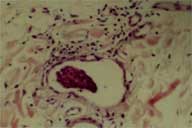Carcinoma erysipelatoides-cutaneous lymphatic vessel spread of a poorly differentiated naso-pharyngeal carcinoma
Published Web Location
https://doi.org/10.5070/D30vj778vfMain Content
Carcinoma erysipelatoides-cutaneous lymphatic vessel spread of a poorly differentiated naso-pharyngeal carcinoma
Dror Guberman1 and C Reinus 2
Dermatology Online Journal 7(2): 7
1. Private practice, Jerusalem 2. Department of Pathology, Shaarei Zedek Medical Center, Jerusalem, IsraelAbstract
Carcinoma erysipelatoides, which is frequently called inflammatory carcinoma, is an uncommon form of skin metastasis. It originates most commonly from breast carcinoma and less often from endometrial or bronchogenic carcinoma. The naso-pharynx is an unusual source for carcinoma erysipelatoides. We present a case of carcinoma erysipelatoides due to poorly differentiated naso-pharyngeal carcinoma.
Report of a case
A 32 year old man presented with a painless, sharply defined, unilateral, erythematous patch on his face and neck (Figure 1) that developed gradually within several months after radiotherapy for the treatment of poorly differentiated naso-pharyngeal carcinoma. Surgery, irradiation and combination chemotherapy failed to control his naso-pharyngeal disease.
A 3 mm punch skin biopsy was performed to differentiate between radiodermatitis and carcinoma erysipelatoides. (Figure 2) It demonstrated normal epidermis with fragments of undifferentiated carcinoma within widely dilated lymphatic vessels in the mid-dermis, diagnostic of carcinoma erysipelatoides.
Discussion
One to four and a half percent of internal cancers metastasize to the skin.[1] Among them, carcinomas of the breast, stomach, lung, uterus, kidney, ovary, colon and urinary bladder are the most common. In one retrospective study of 4020 patients with metastatic disease, 420 (10%) had cutaneous metastases.[2] In 306 of these, the skin metastases were the first sign of extranodal metastasis. The localization and the clinical presentations of these metastases vary. Most often they appear as non-specific nodules.
Carcinoma erysipelatoides is an uncommon form of skin metastasis.[3] Though, it is most commonly called inflammatory carcinoma, the most descriptive term is cutaneous metastatic carcinoma with dermal lymphatic involvement. It originates most commonly from breast carcinoma, and less often from endometrial and bronchogenic carcinoma. The naso-pharynx is a rare source for carcinoma erysipelatoides. It is of interest to note that the development of naso-pharyngeal carcinoma metastases within a field of previous irradiation has been described.[4] Sometimes mistaken for erysipelas, this rare manifestation of metastatic cancer is, unfortunately, associated with a poor prognosis. The patient passed away 6 months after the diagnosis of carcinoma erysipelatoides, which is the median survival of patients with this form of disseminated carcinoma.
References
1. Braverman I.M., Skin signs of systemic disease, 1998; 3rd edition, W.B. Saunders Co. Philadelphia, p 1.2. Lookingbill DP, Spangler N, Helm KF. Cutaneous metastases in patients with metastatic carcinoma: a retrospective study of 4020 patients. J Am Acad Dermatol 1993;29(2 Pt 1):228-36. PubMed
3. Braverman I.M., Skin signs of systemic disease, 1998; 3rd edition, W.B. Saunders Co. Philadelphia, p 3.
4. Meltzer J, Ahmed SA, Archambeau JO. The development of metastases within a field of previous irradiation: a case report. Cancer 1981;48(3):717-20. PubMed
© 2001 Dermatology Online Journal



